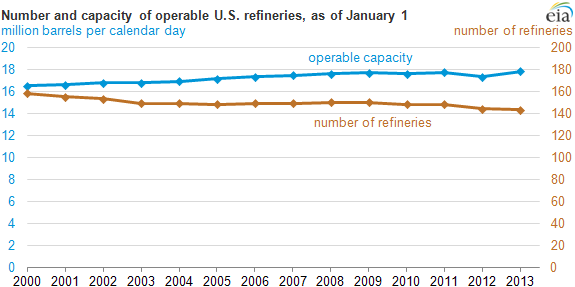
Posted on 07/16/2013 5:33:39 AM PDT by thackney
The U.S. Energy Information Administration (EIA) reported that as of January 1, 2013, the United States had 143 operable refineries with a total atmospheric crude oil distillation capacity of 17.8 million barrels per calendar day (bbl/d), an increase of 0.5 million bbl/d (2.9%) since January 1, 2012.
The increase in capacity as of January 1, 2013, versus the prior year is mostly due to Motiva Enterprises' expansion of its Port Arthur, Texas, refinery and the restart of the Trainer, Pennsylvania, refinery formerly owned by Phillips 66 and now owned by Monroe Energy, a subsidiary of Delta Airlines. Motiva's Port Arthur refinery, with 600,250 bbl/d atmospheric crude oil distillation unit (ACDU) capacity, is now the largest refinery in the United States. According to Oil and Gas Journal, it is one of the ten largest refineries worldwide by crude distillation capacity. Motiva Enterprises is owned 50-50 by Shell and a unit of Saudi Aramco.
Crude distillation capacity is one of the most widely tracked indicators of refinery size; however, the capacity of other secondary units is important as well. Expansion of secondary unit capacity can follow a different pattern over time, as refiners invest in the specific types of capacity needed to support changing crude and product qualities. In 2012, vacuum distillation, thermal cracking, catalytic hydrocracking, catalytic reforming, and hydrotreating capacity all increased, because of unit restarts and expansions, while catalytic cracking capacity was unchanged and deasphalting capacity decreased. In 2013, secondary unit capacity expansion continues as companies work to maximize the production of ultra-low sulfur diesel.
A refinery is classified as idle when the ACDU is not in operation and not under active repair, but is capable of being placed in operation within 30 days; or when the ACDU is not in operation, but under active repair that can be completed within 90 days. A refinery may be idle for any number of reasons including routine maintenance, unplanned maintenance, or shut down because of poor market conditions.
For more information about refinery capacity, see the June 26 edition of This Week in Petroleum, as well as the annual Refinery Capacity Report.

Disclaimer: Opinions posted on Free Republic are those of the individual posters and do not necessarily represent the opinion of Free Republic or its management. All materials posted herein are protected by copyright law and the exemption for fair use of copyrighted works.